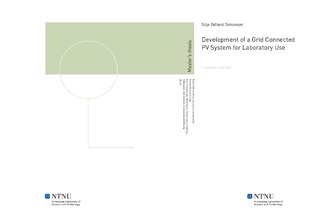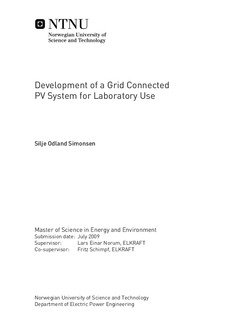| dc.contributor.advisor | Norum, Lars Einar | nb_NO |
| dc.contributor.advisor | Schimpf, Fritz | nb_NO |
| dc.contributor.author | Simonsen, Silje Odland | nb_NO |
| dc.date.accessioned | 2014-12-19T13:51:03Z | |
| dc.date.available | 2014-12-19T13:51:03Z | |
| dc.date.created | 2010-09-03 | nb_NO |
| dc.date.issued | 2009 | nb_NO |
| dc.identifier | 347874 | nb_NO |
| dc.identifier | ntnudaim:4841 | nb_NO |
| dc.identifier.uri | http://hdl.handle.net/11250/256535 | |
| dc.description.abstract | To support the teaching in digital signal processing and control in power electronics a laboratory setup of a PV (photovoltaic) converter system is currently under development at NTNU. The equipment consists of a general reconfigurable power converter and a DSP (Digital Signal Processor) control card with system software for software development and testing. The finished system is intended for implementation in an African University to be used in teaching of PV systems. The power converter stage will be a dual stage consisting of a DC-DC converter and a DC-AC inverter connected to the grid through a transformer stage. For this particular master thesis the input stage comprising the PV panel and the DC-DC converter will be of main focus. A control design will be developed, comprising voltage mode control (with feedback from the input of the converter) and Maximum Power Point Tracking (MPPT). The DC link voltage level is set to be 48 V, while the input voltage will vary from 0 to 45 V. In the experiments the setup will consist of DC source simulating the PV-panel, a DC-DC converter and an electronic load representing the grid connection through an inverter and a transformer. The DC-DC converter was built and tested in a previous master project and can be configured as a buck, boost or buck-boost converter. For this thesis the boost topology was chosen, as this topology is the one most frequently used in PV systems. The control was implemented through C code programming. A regular voltage mode controller was developed and tuned through utilization of Ziegler-Nichols ultimate sensitivity method. At first a P-controller was implemented, but it was not able to cancel out the error between the reference voltage and the input voltage. This was expected, and an integral part was added to form a PI-controller. Now the closed loop control of the system turned out to be rather good for the whole range of the input voltage. The MPPT algorithm Perturb & Observe was chosen to track the maximum power point of operation. The MPPT was tested for both step changes in irradiance and temperature levels. When varying the irradiance level the current was the parameter most affected. Even though the MPP was tracked rather well there was uncertainty regarding the MPPT algorithm capability since the voltage was only exposed to minor changes. When the temperature was changed, the voltage was affected in higher degree. The MPPT was able to track the MPP rather well, and tracking in the wrong direction only happened right after a step change. In real life the temperature will normally not change in steps, so this test was said to be done under extreme conditions. | nb_NO |
| dc.language | eng | nb_NO |
| dc.publisher | Institutt for elkraftteknikk | nb_NO |
| dc.subject | ntnudaim | no_NO |
| dc.subject | SIE5 energi og miljø | no_NO |
| dc.subject | Elektrisk energiteknikk | no_NO |
| dc.title | Development of a Grid Connected PV System for Laboratory Use | nb_NO |
| dc.type | Master thesis | nb_NO |
| dc.source.pagenumber | 142 | nb_NO |
| dc.contributor.department | Norges teknisk-naturvitenskapelige universitet, Fakultet for informasjonsteknologi, matematikk og elektroteknikk, Institutt for elkraftteknikk | nb_NO |

